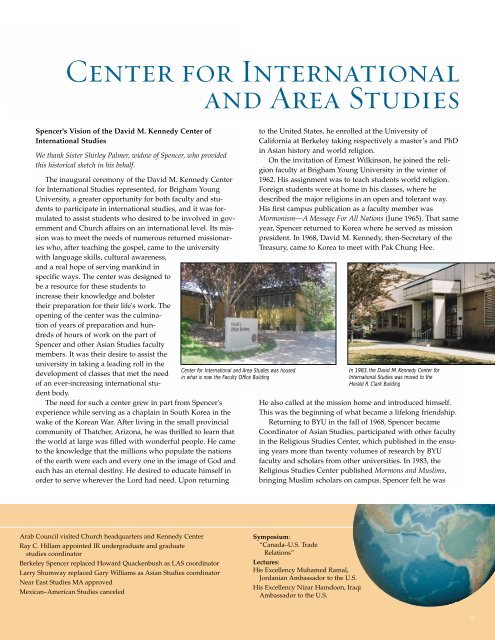BRIDGES - Kennedy Center - Brigham Young University
BRIDGES - Kennedy Center - Brigham Young University
BRIDGES - Kennedy Center - Brigham Young University
You also want an ePaper? Increase the reach of your titles
YUMPU automatically turns print PDFs into web optimized ePapers that Google loves.
<strong>Center</strong> for International<br />
and Area Studies<br />
Spencer's Vision of the David M. <strong>Kennedy</strong> <strong>Center</strong> of<br />
International Studies<br />
We thank Sister Shirley Palmer, widow of Spencer, who provided<br />
this historical sketch in his behalf.<br />
The inaugural ceremony of the David M. <strong>Kennedy</strong> <strong>Center</strong><br />
for International Studies represented, for <strong>Brigham</strong> <strong>Young</strong><br />
<strong>University</strong>, a greater opportunity for both faculty and students<br />
to participate in international studies, and it was formulated<br />
to assist students who desired to be involved in government<br />
and Church affairs on an international level. Its mission<br />
was to meet the needs of numerous returned missionaries<br />
who, after teaching the gospel, came to the university<br />
with language skills, cultural awareness,<br />
and a real hope of serving mankind in<br />
specific ways. The center was designed to<br />
be a resource for these students to<br />
increase their knowledge and bolster<br />
their preparation for their life's work. The<br />
opening of the center was the culmination<br />
of years of preparation and hundreds<br />
of hours of work on the part of<br />
Spencer and other Asian Studies faculty<br />
members. It was their desire to assist the<br />
university in taking a leading roll in the<br />
development of classes that met the need<br />
of an ever-increasing international student<br />
body.<br />
The need for such a center grew in part from Spencer's<br />
experience while serving as a chaplain in South Korea in the<br />
wake of the Korean War. After living in the small provincial<br />
community of Thatcher, Arizona, he was thrilled to learn that<br />
the world at large was filled with wonderful people. He came<br />
to the knowledge that the millions who populate the nations<br />
of the earth were each and every one in the image of God and<br />
each has an eternal destiny. He desired to educate himself in<br />
order to serve wherever the Lord had need. Upon returning<br />
Arab Council visited Church headquarters and <strong>Kennedy</strong> <strong>Center</strong><br />
Ray C. Hillam appointed IR undergraduate and graduate<br />
studies coordinator<br />
Berkeley Spencer replaced Howard Quackenbush as LAS coordinator<br />
Larry Shumway replaced Gary Williams as Asian Studies coordinator<br />
Near East Studies MA approved<br />
Mexican–American Studies canceled<br />
<strong>Center</strong> for International and Area Studies was housed<br />
in what is now the Faculty Office Building<br />
to the United States, he enrolled at the <strong>University</strong> of<br />
California at Berkeley taking respectively a master’s and PhD<br />
in Asian history and world religion.<br />
On the invitation of Ernest Wilkinson, he joined the religion<br />
faculty at <strong>Brigham</strong> <strong>Young</strong> <strong>University</strong> in the winter of<br />
1962. His assignment was to teach students world religion.<br />
Foreign students were at home in his classes, where he<br />
described the major religions in an open and tolerant way.<br />
His first campus publication as a faculty member was<br />
Mormonism—AMessage For All Nations (June 1965). That same<br />
year, Spencer returned to Korea where he served as mission<br />
president. In 1968, David M. <strong>Kennedy</strong>, then-Secretary of the<br />
Treasury, came to Korea to meet with Pak Chung Hee.<br />
In 1983, the David M. <strong>Kennedy</strong> <strong>Center</strong> for<br />
International Studies was moved to the<br />
Herald R. Clark Building<br />
He also called at the mission home and introduced himself.<br />
This was the beginning of what became a lifelong friendship.<br />
Returning to BYU in the fall of 1968, Spencer became<br />
Coordinator of Asian Studies, participated with other faculty<br />
in the Religious Studies <strong>Center</strong>, which published in the ensuing<br />
years more than twenty volumes of research by BYU<br />
faculty and scholars from other universities. In 1983, the<br />
Religious Studies <strong>Center</strong> published Mormons and Muslims,<br />
bringing Muslim scholars on campus. Spencer felt he was<br />
Symposium:<br />
“Canada–U.S. Trade<br />
Relations”<br />
Lectures:<br />
His Excellency Muhamed Ramal,<br />
Jordanian Ambassador to the U.S.<br />
His Excellency Nizar Hamdoon, Iraqi<br />
Ambassador to the U.S.<br />
9


